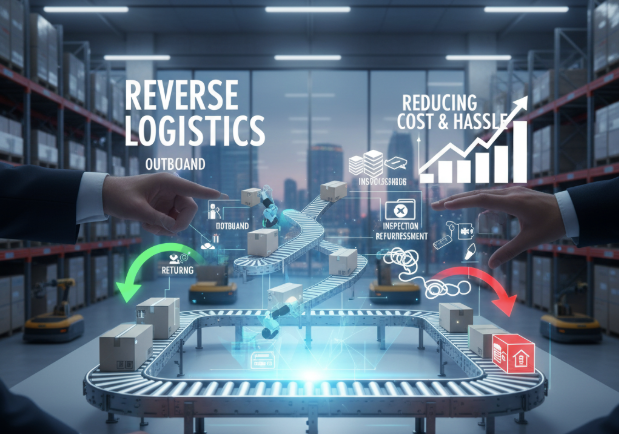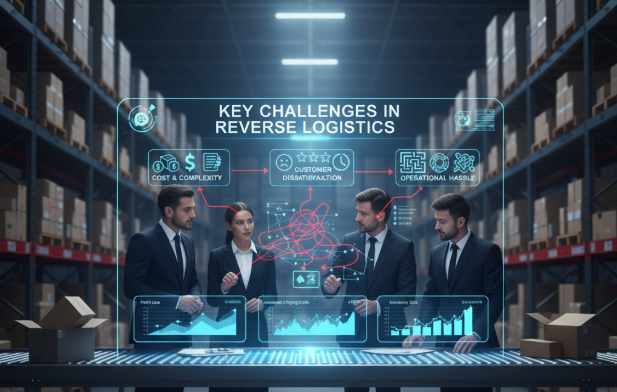
Sign up for a free trial and your first month is $1. Sign up now


In the fast-paced world of eCommerce, forward logistics — getting products into customers’ hands — gets most of the attention. Yet, what happens after the sale can be just as important. Reverse logistics, the process of handling returns, repairs, exchanges, and recycling, is a critical part of the online retail experience.
For many brands, managing returns has become a financial and operational headache, while for others, it’s an opportunity to enhance efficiency, sustainability, and customer satisfaction. As return rates in online shopping continue to climb, mastering reverse logistics is no longer optional — it’s a competitive necessity.
Reverse logistics refers to the process of moving goods from customers back to sellers or manufacturers. It includes handling returns, managing exchanges, repairing or refurbishing items, recycling damaged goods, and restocking sellable inventory. In essence, it’s everything that happens after a customer decides they no longer want or need a product.
Unlike forward logistics, which is linear and predictable, reverse logistics is complex and reactive. Returns can come from anywhere, at any time, and in varying conditions. For online retailers, this poses logistical and financial challenges — but also opportunities to build loyalty and reduce waste.
Reverse logistics plays a key role in the customer experience. When shoppers know they can return items easily, they’re more likely to buy. However, disorganized reverse processes can frustrate customers, drain profits, and tie up valuable inventory. With modern consumers expecting flexible and transparent return policies, efficient reverse logistics has become essential to maintaining both trust and profitability.

Managing reverse logistics efficiently isn’t easy. It involves multiple moving parts, each of which can add complexity and cost. The most common challenges include:
These challenges highlight why reverse logistics must be viewed as a strategic process, not a secondary one. Without proper management, returns can quietly erode margins and undermine customer confidence. But with planning, data, and technology, businesses can turn this operational burden into a source of efficiency and loyalty.
Reducing the cost and hassle of reverse logistics begins with a proactive approach. Instead of simply reacting to returns, successful brands design systems that make the process smoother for both customers and internal teams.
One of the most effective strategies is implementing clear and automated return policies. Ambiguous or manual policies slow down approvals and confuse customers. Using automated return portals — such as Loop or Returnly — helps streamline requests, generate shipping labels, and track items in real time.
Another cost-saving method is centralizing return processing. Consolidating returned products at regional or centralized centers allows retailers to inspect, categorize, and restock inventory faster, reducing transportation and storage costs.
Partnering with third-party logistics providers (3PLs) that specialize in returns management can also reduce overhead. These partners often have optimized networks and systems to handle inspection, refurbishment, and resale efficiently.
Analyzing return data is another critical strategy. By understanding why customers return products — whether it’s sizing issues, misleading product descriptions, or damaged packaging — businesses can make upstream improvements that reduce return rates altogether.
Ultimately, effective reverse logistics blends automation, data analysis, and smart partnerships. The goal isn’t just to process returns cheaply but to build a return system that strengthens brand reputation and reduces waste over time.
Technology has revolutionized nearly every part of eCommerce, and reverse logistics is no exception. From artificial intelligence (AI) to automation, digital tools help streamline the return process, enhance transparency, and lower costs.
AI and predictive analytics play a major role in identifying return trends and improving product accuracy. By analyzing return reasons, brands can adjust product listings, size charts, and shipping methods to prevent future issues. AI can even predict which products are most likely to be returned and flag potential quality or expectation mismatches.
Barcode scanning and RFID tracking technologies simplify the physical handling of returns. Once a return label is scanned, all relevant information — from order details to restocking instructions — becomes instantly available. This minimizes human error and accelerates refund processing.
Automation and integration with eCommerce platforms also help. When return systems are connected to tools like Shopify, WooCommerce, or ERP platforms, they can automatically update inventory, issue refunds, and generate analytical reports. Customers receive instant notifications, and warehouses can restock faster, keeping the supply chain fluid.
Technology not only increases efficiency but also provides visibility. Both customers and retailers benefit from real-time updates on return status, eliminating uncertainty and improving trust. Over time, these innovations create a return process that’s not just operationally sound but also customer-friendly.
As consumers become more eco-conscious, sustainability has become a crucial element of reverse logistics. Inefficient return systems contribute to waste — products often end up in landfills, and transportation emissions rise as items move back and forth between warehouses. The green return movement aims to fix this by rethinking how returns are handled.
Retailers can start by adopting recycling and refurbishing programs. Returned products that are slightly damaged or opened can be repaired, repackaged, or resold as “like-new” items at a discount. This approach not only minimizes waste but also recovers value from products that would otherwise be discarded.
Consolidating shipments is another sustainable practice. Encouraging customers to return multiple items together reduces transportation emissions and packaging waste. Some brands also use biodegradable or reusable packaging to make returns more eco-friendly.
Additionally, offering digital refunds or store credits instead of physical exchanges reduces the need for new product shipments. This approach helps manage inventory while promoting circular commerce — where products and materials are reused rather than wasted.
Sustainable reverse logistics isn’t just good for the planet — it’s good for business. It attracts environmentally conscious shoppers and lowers operational costs in the long run by optimizing resources and minimizing wasteful returns.

While cost and efficiency matter, the customer experience remains the heart of reverse logistics. A smooth, transparent return process is one of the strongest tools for building trust and loyalty in eCommerce.
Customers expect convenience. They want to initiate returns easily, track their progress, and receive timely refunds. Retailers that make this process seamless stand out from competitors. Self-service return portals, prepaid labels, and automated updates are key features that reduce friction and enhance satisfaction.
Transparency is equally important. Shoppers appreciate clear communication about timelines, eligibility, and refund status. Providing proactive updates at every stage — from receipt to refund — eliminates anxiety and builds confidence.
Smart retailers go beyond convenience by turning returns into engagement opportunities. For instance, offering store credit instead of refunds keeps customers within the brand ecosystem. Personalized recommendations during the return process can encourage exchanges rather than cancellations.
In short, a customer who experiences an easy, fair return is far more likely to buy again. Reverse logistics, when done right, doesn’t just recover products — it strengthens relationships.
Reverse logistics has evolved from a logistical afterthought into a strategic pillar of eCommerce success. By streamlining returns, adopting smart technology, and emphasizing sustainability, businesses can reduce costs and enhance efficiency without sacrificing customer satisfaction. The goal isn’t to eliminate returns — it’s to manage them intelligently. A transparent, data-driven reverse logistics system turns operational complexity into a competitive advantage.
As eCommerce continues to expand, brands that master the art of reverse logistics will enjoy more than just savings — they’ll build stronger trust, foster long-term loyalty, and create a truly circular, sustainable shopping ecosystem.